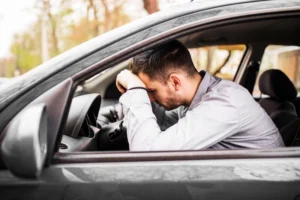Car accidents are stressful, but they become even more frustrating when the at-fault driver has no insurance. In South Florida, where road congestion and accidents are common, dealing with an uninsured driver can make the situation feel even more overwhelming. But don’t panic, you can take steps to protect yourself and ensure you’re not left covering all the costs.
This guide will walk you through what to do if you find yourself in this tricky situation and provide actionable advice to help you recover damages even if the at-fault driver has no insurance.
Understanding Florida’s Insurance Laws
 Before diving into what to do after an accident with an uninsured driver, it’s important to understand Florida’s insurance requirements.
Before diving into what to do after an accident with an uninsured driver, it’s important to understand Florida’s insurance requirements.
Florida’s No-Fault Insurance System
Florida follows a no-fault insurance system, meaning that after an accident, you typically file a claim with your own insurance company regardless of who was at fault. However, this doesn’t mean that the at-fault driver is completely off the hook.
Minimum Insurance Requirements in Florida
Florida requires all drivers to carry:
Personal Injury Protection (PIP): Covers medical expenses, lost wages, and some other costs, up to $10,000.
Property Damage Liability (PDL): Covers damage to another person’s vehicle or property, also up to $10,000.
Unlike other states, Florida does not require drivers to carry Bodily Injury Liability (BIL) coverage, which can make recovering damages from an uninsured driver even more challenging.
Steps to Take After an Accident with an Uninsured Driver
If you’ve been involved in an accident where the at-fault driver has no insurance, follow these crucial steps to protect yourself:
1. Call the Police
Always report the accident to the police. A police report serves as an official record of the crash and will be helpful when filing an insurance claim or pursuing legal action. The report may include:
Witness statements
The at-fault driver’s admission of responsibility
Notes about traffic violations or reckless driving
2. Gather Evidence at the Scene
Without an insured driver to rely on, having solid evidence is essential. If it’s safe to do so, collect the following:
Photos and videos of the accident scene, vehicle damage, and any visible injuries
Witness contact information and statements
The at-fault driver’s contact details, even if they don’t have insurance
3. Notify Your Insurance Company
Report the accident to your insurer as soon as possible. Since Florida is a no-fault state, you’ll need to file a claim with your own Personal Injury Protection (PIP) coverage first to cover medical expenses.
If your damages exceed your PIP limits, you may need to explore other options, which we’ll discuss below.
4. Check Your Uninsured Motorist (UM) Coverage
One of the best ways to protect yourself against uninsured drivers is by having Uninsured/Underinsured Motorist (UM/UIM) coverage. While not required in Florida, it’s highly recommended because it helps cover:
Medical bills
Lost wages
Pain and suffering
Long-term rehabilitation costs
If the at-fault driver has no insurance, UM coverage can be a lifesaver. File a claim with your insurance provider to cover damages.
5. Explore Other Insurance Options
If you don’t have UM coverage, other parts of your insurance policy might help:
Collision Coverage: Covers repairs to your vehicle, regardless of fault.
Medical Payments Coverage (MedPay): Helps with medical expenses beyond what PIP covers.
These coverages can help offset costs, but you’ll likely need to pay your deductible first.
Legal Options for Recovering Damages
If your insurance doesn’t fully cover the damages, you may have legal options to seek compensation.
1. Sue the At-Fault Driver
You can file a personal injury lawsuit against the uninsured driver to recover expenses such as:
Medical bills
Lost wages
Pain and suffering
However, if the at-fault driver has no insurance, they may not have the financial resources to pay a judgment, making collection difficult.
2. Explore Small Claims Court
If the damages are relatively minor, you may consider filing a claim in small claims court, which handles cases involving smaller amounts (typically under $8,000 in Florida). This process is quicker and less expensive than a full lawsuit.
3. Wage Garnishment or Asset Seizure
If you win a lawsuit against the uninsured driver, you may be able to collect compensation through wage garnishment or asset seizure, though this can be a lengthy process.
Preventing Financial Loss from Uninsured Drivers
Since South Florida has a high number of uninsured drivers, it’s a good idea to take proactive steps to protect yourself:
1. Add Uninsured Motorist Coverage
This is one of the best investments you can make. If the at-fault driver has no insurance, this coverage provides an extra layer of protection.
2. Consider Higher PIP Limits
Standard PIP coverage may not be enough in serious accidents. Check with your insurer to see if increasing your limits is an option.
3. Drive Defensively
While you can’t control other drivers, practicing defensive driving can reduce your chances of being in an accident where the at-fault driver has no insurance.
4. Research Legal Aid Options
If you’re in a tight spot financially after an accident, local legal aid services may offer free or low-cost consultations to explore your options.
Protecting Yourself When the At-Fault Driver Has No Insurance
Being hit by an uninsured driver is stressful, but knowing how to handle the situation can make a big difference. In South Florida, where uninsured drivers are common, taking the right steps like gathering evidence, filing an insurance claim, and exploring legal options can help you recover damages more effectively.
The best way to protect yourself is by preparing ahead of time. Make sure you have the right insurance coverage, drive safely, and know what to do if the at-fault driver has no insurance.
If you ever need to sell your damaged vehicle for cash quickly, knowing your options can save you time and hassle. Stay safe on the roads and be prepared for anything!

